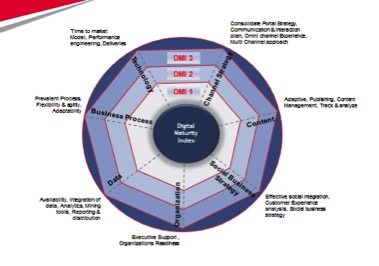Who would have dreamt that within two years the demand from communication service providers for digital capabilities would rank alongside those of IT, research and development and innovation in one of Gartner’s surveys – Increasing Investment Areas, 2012, 2013 and 2014 Rankings: A Shift to Longer-Term Thinking.
Yes, our world indeed has made swift strides toward digitization since 2012. With the goal to provide 80% of sales and service via online, demand for information – the right data at the right time, connected lifestyle services, collaborative innovation and bridging of the last mile with software-defined networking. Some obvious drivers for these fast-paced developments include:
• Digital convergence eroding national and international boundaries;
• Digital experience delivery impacting a firm’s success in the business world;
• Business becoming more comfortable with data, mobile and cloud; and
• Sensors and devices drawing ecosystems together.
In this digital era, “consumerism” is the new mantra. It is no longer about the company’s terms and conditions, but about the customer’s terms and conditions. Doing business the customer way is the mantra of success. Providing timely access to information, transparency in implementation, standout omni-channel experience and creating more personalized engagements are certain imperatives CSP’s need to overcome to differentiate the way they now connect with their customers and prospects. Also, as predicted by Gartner, lack of digital business competence will cause 25% of businesses to lose competitive ranking by 2017. According to Gartner’s 2014 CIO survey, 63% of CSP CIOs agree that the torrent of digital disruptions threatens both business success and their IT organizations’ credibility. In addition, 66% of them believe their current IT organization lacks the key skills and capabilities necessary to respond to a complex digital business landscape. Hence, where exactly the CSPs stand in terms of the digital maturity index is something CSPs should be paying attention to, now more than ever.
There is a need for developing a systematic assessment framework to gauge the digital maturity of any CSP. We believe there are three levels of maturity that have been defined in our DMI map:
• DMI 1 depicts that the organization is at the elementary level of maturity. While this is a good step, there are still lots of miles to cover.
• At DMI 2, organization would be more mature on the digital front whereby mobile, analytics and agility would be an integral part of the organization’s operation. Typically these organizations would have already started or need to start their journey toward DMI 3 in order to monetize their digital efforts.
• DMI 3 proposes a customer-centric services philosophy, which requires an organization to get close to the customer and incorporate customer feedback into its business’ decision-making process. Taking 360-degree customer inputs on product quality, new product/service ideas and other areas touching the customer life cycle becomes essential. DMI Level 3 maturity requires developing a set of customer-centric business processes whereby services would not be ordered, billed or even paid for in the traditional way. Processes need to be redesigned to respond directly to the customer in near real time.
This is beneficial for both CSPs and customers as it enables CSPs to dynamically offer personalized services based on the customer needs and behavior patterns disclosed through analytics. The customers gain the flexibility to make choices and use on-demand services. This also opens immediate upsell opportunities as the near-real-time controls can determine a customer’s privileges while he is accessing the network.: Moderating the available capacity of the network based on the load and subscription level of the customer while services are being consumed to avoid congestion; enabling the customer to enforce his preferences on spending limits, parental control and selective view by time of day, etc.; require the ability to enforce policies and entitlements and make service decisions, in near real time. Traditional business support systems typically lack the ability to support these new processes.
Also, passive service support will not work as highly personalized services, since a one-time view to premium content or an on-demand data request would require immediate or near-real-time provisioning and billing of services. This also provides opportunities to upsell content and services that are directly relevant to customers’ current usage and consumption pattern. To enable customers to make payments using different modes of payments – such as credit/debit cards or promotional codes – available for content and bandwidth used in addition to the monthly subscription, CSPs need the flexibility to monetize these opportunities and not be constrained by existing processes.
This calls for undertaking major transformation projects toward a single, service-delivery-0riented, end-to-end all-IP infrastructure at the network level. Operational support systems that are network facing and BSS – encompassing software that supports billing and charging; customer management; product design and management; sales and marketing; order and order activation – are highly complex transformational projects, the transformation OSS/BSS is aimed at leveraging, transforming, converging, optimizing and streamlining business operations.
It is imperative for the transformation leaders to have a thorough understanding of the organization’s current maturity, its systems and processes. Engaging with the digital ecosystem requires a great deal of experimentation and an ability to deal with uncertainty. Thus, IT needs to adopt innovative and adaptive methods that can leverage a modular, reusable approach to designing services and product offers. The leader has to have a holistic approach to ensure that the digital journey is done smoothly. Tools, techniques and framework suggested here can be used for a successful transformation to the digital world.
Summing up, the transformation journey to the digital world for the CSPs would not be easy, given that they have huge stacks of legacy systems, but it is a journey they will have to take to survive in the new CSP world.
Editor’s Note: In an attempt to broaden our interaction with our readers we have created this Reader Forum for those with something meaningful to say to the wireless industry. We want to keep this as open as possible, but we maintain some editorial control to keep it free of commercials or attacks. Please send along submissions for this section to our editors at: dmeyer@rcrwireless.com.


